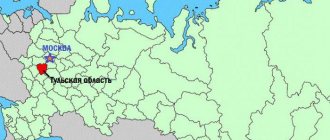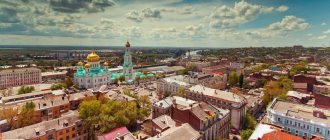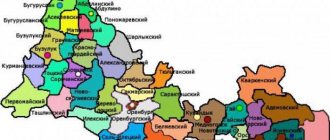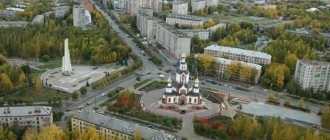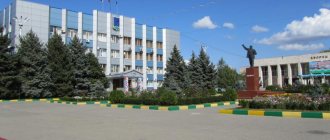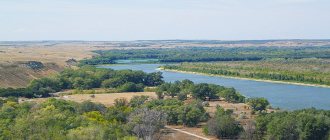The Rostov region is a very important region of the Russian Federation both in strategic terms and in the extraction of all kinds of raw materials and energy resources. The region itself is small, its area is only about 100 thousand km2. There are 23 cities in this region, each of which has its own history and main processing, manufacturing or mining resource.
Below are lists of cities in the Rostov region, divided by main economic, demographic, social and energy parameters.
Where is Rostov-on-Don located?
Rostov-on-Don (popularly also called Rostov, which is why many people confuse it with the ancient city of the same name in the Yaroslavl region) is the largest city in the southwestern part of Russia, and is the administrative center of the Southern Federal District and the Rostov region.
The city is located in the southeastern part of the East European Plain, mostly on the right bank of the Don. On the left side of the river there is an industrial zone, recreation centers, a shopping center and a new football stadium built for the 2018 World Cup. In terms of time, Rostov is included in the Moscow time zone (MSK), relative to UTC the offset is +3:00. The exact online time in the city is available on the website TimeServer.ru.
I. Rating of Rostov suburbs
"Amber": the most prestigious
(Main article: Yantarny village).
The very first suburb, located 2–3 kilometers north of Rostov-on-Don (along the M-4 Don highway from the village of II Ordzhonikidze, which is part of the city), with a total area of 110 hectares. Its construction began in 1991, at the end of Soviet times, when a number of departments formed and allocated more than 1,000 land plots to their employees in need of improved housing conditions.
It was assumed that the state would provide support to residents by developing social and communal infrastructure here. But, as we know, few of those in power keep their promises. The Yantarny building under construction near Rostov has not passed this point, especially considering that the suburb began to develop in the cash-strapped 1990s.
However, even in those days, the demand for individual housing began to grow in Rostov; as a result, the suburb became attractive to wealthy citizens who wanted to build their own home here. Of course, the not very comfortable “Yantarny” was not the best option for building a house near Rostov. But if you consider that due to the shortage of land, mansions grew even in gardening partnerships intended for growing potatoes, the territory of Yantarny was far from the worst option.
This is evidenced by the fact that once in this suburb, ex-Don Governor Vladimir Chub built a dacha for himself, not to mention other representatives of the bureaucratic elite of Rostov and the region. Subsequently, the intensively developed suburb of Rostov urbanized two closely adjacent villages: Kamyshevakha (by the way, the latter is where the dacha of the current governor, Vasily Golubev, is located) and Vodopadny, in which houses for wealthy Rostovites also began to appear.
Today, more than four thousand people live in the “Yantarny” village alone (along with it, Kamyshevakha and Vodopadny are perceived by some residents of Rostov as a single suburb). Most of the two dozen streets of Yantarny have full-fledged engineering and are even landscaped. And today officials who care for the people are building and completing social facilities: a school, a first-aid post, a kindergarten, which should have been put into operation more than twenty years ago.
Since the 1990s, the Yantarny suburb has been a kind of fair for the residents of Rostov for the purchase and sale of decent plots of land, while the cost of land with all communications here is quite expensive and reaches 500–550 thousand rubles per hundred square meters. Ready-made housing - new cottage buildings and individual houses in the secondary market, as life has shown, are in much less demand here. This, one must think, is the prevailing mentality in this suburb, which attracts citizens of Rostov who want to build their “dream home.”
At the same time, today the development of the largely spontaneously formed village continues. The popular and well-known suburb attracts developers from Rostov and surrounding cities who want to join. As a result, cottage settlements under construction are now closely adjacent to Yantarny, which can be perceived as its new, more advanced phases (lack of chaotic development, fenced area), and they charge less for the land being sold here.
Nowadays, private investors are approaching Yantarny, wanting to equip the adjacent lands with engineering at their own expense. As a result, cottage villages are growing around the established suburb, which at the same time can be called new lines of Yantarny.
"Emerald": the village "Yantarny" with a plus
(Main article - “Emerald”: build your dream house in the village!)
The Izumrudny cottage community is one of the new, more advanced lines of Yantarny, which is at the highest stage of readiness. Most of the land plots here have already been sold (as of summer 2013).
We decided to give this development, also closely adjacent to Yantarny, the additional name “Yantarny +”. In terms of its idea and geographical location, the Izumrudny cottage community continues the traditions of the historically formed north-eastern suburb of Rostov and at the same time is in the highest stage of readiness.
The fundamental difference between Izumrudny and Yantarny is that it is sold by a private investor using his own funds. In accordance with the plan, full-fledged engineering and social infrastructure facilities are being built here - in a fenced area (1) . This is the undoubted advantage for buyers of land in Izumrudny.
For comparison: the formation of the Yantarny suburb, which was spontaneously built up with expensive housing without an investor, took about 20 years. The project of the Izumrudny cottage village started in late autumn 2011. Currently (summer 2013) its territory is suitable for permanent residence: all communications have been installed, landscaping is underway, a park and other social facilities are being built. At the same time, most of the land plots formed in the cottage village have already been sold. Currently, real estate buyers are actively developing the territory of the village, and this project will soon be implemented.
Another interesting nuance is that land plots in Izumrudny are cheaper than land in the well-maintained quarters of Yantarny, although a better living environment is being formed here (for some land plots in Yantarny they are asking for 500-550 thousand rubles per hundred).
“Ornamental crops”: the most abandoned
(Main article: “Ornamental crops.”)
This suburb lies on the territory of two municipalities at once: Rostov and Aksai district. The main landmark and attraction is the Rostov Sea reservoir. The southern shore of the reservoir belongs to the territory of the metropolis, the northern - already to Aksai.
“Ornamental crops” are the closest neighbor of “Yantarny” (Kamyshevakha, Vodopadny) - if you drive from this suburb a little to the southwest, towards Rostov. Strictly speaking, its formation began in the second half of the 20th century, when workers of the now bankrupt state farm of the same name, as well as some other enterprises, organized self-development on local lands allocated for gardens.
Unlike Yantarny, in those days it was much more difficult to bring full-fledged networks from Rostov to Decorative Crops; the suburb was in a pitiful state. The main type of real estate that exists here is chaotically built-up gardening partnerships.
The lack of engineering did not make it possible to build capital housing in “Ornamental Cultures”; self-development grew here - by the forces of summer residents in need of improved living conditions. Its total area exceeds 250 thousand square meters. meters - although many of the illegally erected buildings were subsequently amnestied.
The main weak link of the suburb was the shortage of water supply and sewerage networks, with which it is only now being equipped, during the implementation of the “Water of Rostov” program. At the same time, with the arrival of civilization in these parts in the form of housing and communal services, the first stage of “Ornamental Crops” was given over, among other things, to multi-storey buildings, on which a corresponding agreement was reached with some large companies.
In particular, the developer of the Leventsovsky district . It is planned to build even a high-rise block on the territory of Decorative Cultures .
In general, if earlier the lack of engineering did not allow “Ornamental crops” to develop chaotically, now it will begin to sharply urbanize. Although there will also be quiet corners for low-rise construction, untouched by civilization.
These, in particular, include the cottage village "Paris" , located on the border of Kamyshevakha (read, "Yantarny") and "Ornamental Cultures". The fate of self-development in many poor gardening partnerships is still unclear.
"Orbitalnaya-Rostov": the most urbanized
Perhaps this area should not have been included in the suburbs of Rostov, since to a greater extent it already now resembles an urbanized satellite city located next to “Ornamental Crops”. We are talking about the intensive development of high-rise residential complexes that has unfolded to the north of Orbitalnaya Street.
But if you go further north, the “high-rise buildings” will gradually give way to “low-rise buildings.” Nearby landmarks can be the Auchan and Mega hypermarkets built “in the North” (not to be confused with similar stores on the M-4 Don highway, which runs in the north-east direction) and the north-eastern outskirts of the city cemetery.
Some of the local low-rise neighborhoods are positioned by developers as cottage villages in Rostov-on-Don, although they have nothing in common with such, being not fenced and not fully landscaped, not to mention the absence of a unified philosophy of development and architectural composition. With the same success, the oldest low-rise microdistrict in Rostov, which appeared in the 19th century, “New Settlement,” can be called a cottage village.
This is simply a new “private sector” zone on the outskirts of the metropolis.
"Shchepkin": the most dental
(
Rostov-on-Don Airport
There is a large international airport “Platov” in Rostov-on-Don (the name has not yet been established in society, as it was assigned only in 2021). It is located between Rostov (29 km northeast) and Novocherkassk (15 km northwest). In 2018, passenger traffic amounted to about 3.2 million passengers, 0.7 million of which were on international flights, the rest on domestic flights.
The airport serves more than 20 airlines, a third of which are foreign air carriers. The geography of flights from Platov, not counting domestic flights, covers all CIS countries, many countries in Europe, Asia and Africa. Popular flights around the country are Moscow, St. Petersburg, Kazan, Samara, Chelyabinsk, Sochi and others. Popular international flights are Antalya, Dalaman, Dubai, Yerevan, Tashkent, Prague, Istanbul, Tbilisi, Enfidha, etc.
You can get to Platov airport from Rostov by a special bus departing from Station Square. From Novocherkassk buses depart from the central railway station.
Advantages of the Sea of Azov
The water in this area has healing powers - it contains 92 elements from the well-known periodic table. That is why there are many sanatoriums, hotels, hotel complexes, recreation centers, camps and dispensaries on the coast of the Azov Sea. This water significantly improves immunity and treats a considerable number of various diseases.
On very hot days, the sea temperature reaches +30 °C. Due to the fact that the depth begins to increase only from about 20 meters from the beach, this place is considered a paradise for families with children. The only thing that can upset tourists who come in August is the blooming water. At this time, the sea somewhat loses its attractiveness.
Train Station
In Rostov (Privokzalnaya Square, 1/2) there is one passenger railway station - Rostov-Glavny, which includes two stations - Glavny and Prigorodny. Trains depart from here throughout the Rostov region and a large number of remote Russian cities. The most popular destinations are Moscow, Yekaterinburg, St. Petersburg, Adler, Anapa, Murmansk, Novorossiysk and others. International flights throughout the CIS also operate from the station, but for the most part with transfers in Moscow, Syzran and other cities.
Also in Rostov-on-Don there is a station “Pervomaiskaya” (Peskova Street, 1/3), serving freight and freight trains.
Taganrog
For those who value peace and quiet, a holiday in the Rostov region on the Sea of Azov is perfect. Everyone who comes to Taganrog will personally see this.
There are a lot of beaches in the city. All of them are quite well equipped. For example, you can visit Primorsky, Central or Solnechny. The beaches provide sun loungers and umbrellas for sunbathers, and various attractions for children. There are small shops and cafes on site where you can buy groceries or have a snack.
Another important advantage of a holiday in Taganrog is reasonable prices. If compared with the Black Sea, the costs will be approximately half as much.
Bus stations of Rostov-on-Don
Rostov has two bus stations - “Glavny” (the main one) and “Prigorodny” (popularly called the old one). From the central bus station there are flights to 137 directions (about 400 departures/arrivals of buses and minibuses per day).
Most flights are carried out in cities and villages of the Rostov region and the Southern Federal District as a whole. Flights are available to the Crimean Peninsula, as well as to border settlements in Kazakhstan. More than 20 intermediate bus stations are scattered throughout the city.
II. Interesting nuances
▪ In the suburbs located in the northern outskirts of Rostov, thousands of land plots have been created for individual development. Experts believe that as a result, land prices should fall in the coming years; only high-quality areas with modern, high-quality engineering and ready-made social infrastructure will be in high demand.
▪ Preparations for the 2018 FIFA World Cup promise to sharply increase demand for real estate in the southern suburbs of Rostov. Let’s not forget: on the eve of the World Cup, it is planned to triple the capacity of the Voroshilovsky Bridge, not to mention the infrastructure development of the left bank lands and the construction of numerous social facilities.
▪ Over the past years, not a single decent suburb has been formed in the western outskirts of Rostov, unlike the north and south. Although the existing demand is evidenced by the fact that more and more Rostovites are considering purchasing real estate in the village of Obukhovka, located in these parts.
▪ The eastern outskirts of the capital of the Southern Federal District are “idle” to an even greater extent. The situation is largely explained by the fact that on this side of Rostov the satellite city of Aksai is closely adjacent. Thus, the construction of a suburb is possible only outside its borders.
▪ Perhaps in a few years a very specific suburb for large families will appear near Rostov, located north of Shchepkin, on the territory of the Rassvetovsky rural settlement. In 2013, Rostov authorities began work on planning and land surveying with a total area of 250 hectares.
Automobile transport
The following highways pass through Rostov or in its immediate vicinity:
- M4 "Don" is the largest federal highway, entering Rostov from the south along the access road A135. Connects the city with Moscow, Voronezh, Krasnodar and Novorossiysk.
- A280 (formerly M23) is a federal highway from Taganrog to the Ukrainian border.
The M4 Don highway, in turn, is part of the European routes E115 (Yaroslavl - Novorossiysk), E97 (Kherson - Ashkala), E50 (Brest - Makhachkala), E38 (Glukhov - Shymkent), etc.
Rest in Petrushino
For those who want to have an inexpensive but full-fledged summer vacation, it is suggested to visit the village of Petrushino. There is a large sandy beach here. It is equipped with changing cabins and showers. Adults can rent jet skis, or ride a banana boat. Children won't be bored either, because there is a slide on the beach. As a rule, it is crowded here only on weekends and in the evening. Local residents provide rooms and houses for rent to tourists. To Taganrog every 30 minutes. there is a bus.
What is Rostov-on-Don famous for?
Unofficially, Rostov-on-Don is considered the “southern capital of Russia” and the Don capital. But the city is still better known by its “nickname” Rostov-Papa, which stuck to it from the criminal world. Over the past 150 years, Rostov-on-Don has been the most criminal city in Russia, where not only petty thieves and pickpockets, but also criminals of much larger stripes have long operated. Although today the situation with crime has changed dramatically, Rostov-on-Don was a “father” for its residents, and remains so to this day.
But this is how Rostov appears only to residents of Russia, and even then not to everyone. Ordinary tourists appreciate the city for its large number of historical attractions, music schools (Rostov is the largest jazz center in the country), beautiful embankment landscapes and much more.
III. Photo gallery
The same dacha of ex-governor Vladimir Chub in Yantarny - if you believe local rumors.
"Amber": general panorama.
Developed construction in the cottage village "Izumrudny" - a new "version" of "Yantarny".
Panorama of the first street, Rostovskaya, that opened in the Donskaya suburb.
The Rostov cottage community “Donskoy” is the most strict in terms of adherence to the architectural concept. Even fences are part of the overall appearance. These are its pros and cons: the buyer moves into a beautiful environment and ready-made housing, but as a result, you will no longer be able to take any “liberties” here.
Construction of Azovskaya Street in Donskoy.
In "Solnechny".
Traffic jams on one of the roads to Shchepkin.
Some developers “north of Orbitalnaya” began to position their real estate as cottage villages, which have nothing to do with them.
"Belovodye": this is how it all began.
The Transfiguration Church is the main architectural landmark of the Obukhovka farm and a dominant feature in the surrounding area.
Notes:
- Website of the cottage village "Izumrudny".
- “Norald Nersesyants: “It’s time to unite Rostov with Aksai and Bataysk” // “Vestnik. Construction. Architecture. Infrastructure" No. 1 2007
- Real estate sellers about the bad influence of the Northern Bypass/“Cottages by the Bypass”//City N, October 2, 2012
- Belovodye Village Forum
Family holiday
The Azov Sea is ideal for a family vacation. On the coast of Taganrog Bay you can relax in the following places.
- Pavlo-Ochakovskaya spit. OK "Breeze" occupies an area of 6.5 hectares. There is a boarding house and a children's camp here. You can also relax with tents. The price category is average. There is a football field and sports grounds on the territory. The canteen and cafe are constantly open. The beach is sandy, the water is clear. Lovers of the underwater world will not be bored here.
- The village of Zaimo-Obryv. The Eden base offers tourists accommodation in equipped hotel rooms or cottages. Prices are average - about 2,000 rubles. The territory is equipped according to modern requirements.
- Sedykh Farm. Not far from the city of Azov there is a tourist center "Raduga". It is perfect for those who want to save on accommodation. The area is equipped with attractions and there is a playground for children. Guests are offered accommodation in cozy wooden houses or rooms designed for 2-4 people.
Holidays in the Rostov region on the Azov Sea have always been popular among a significant number of people. Tourists come to these places from all regions of Russia. And in 2021, this flow has almost doubled, since it is simply impossible to find a better ratio of price and conditions.
